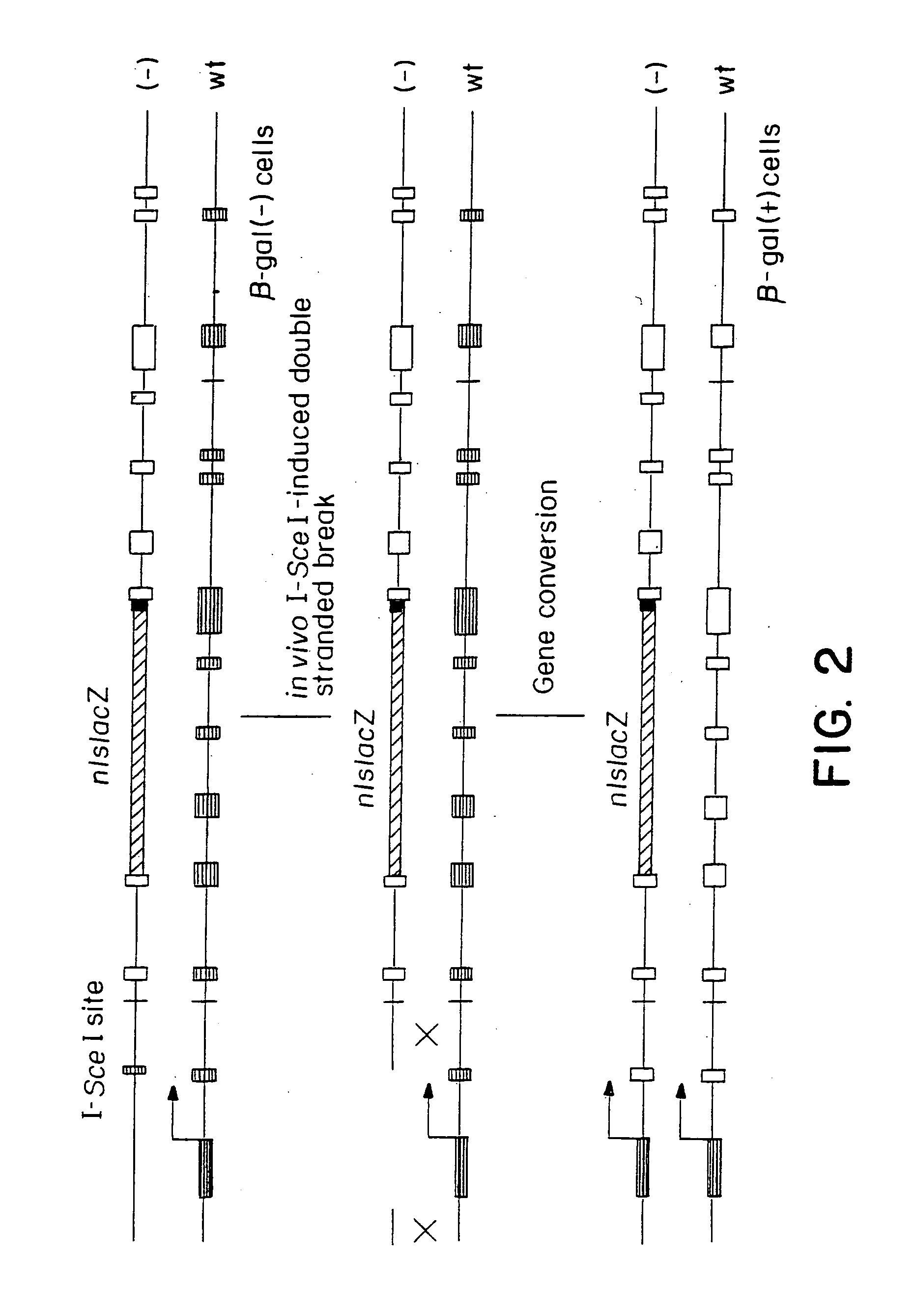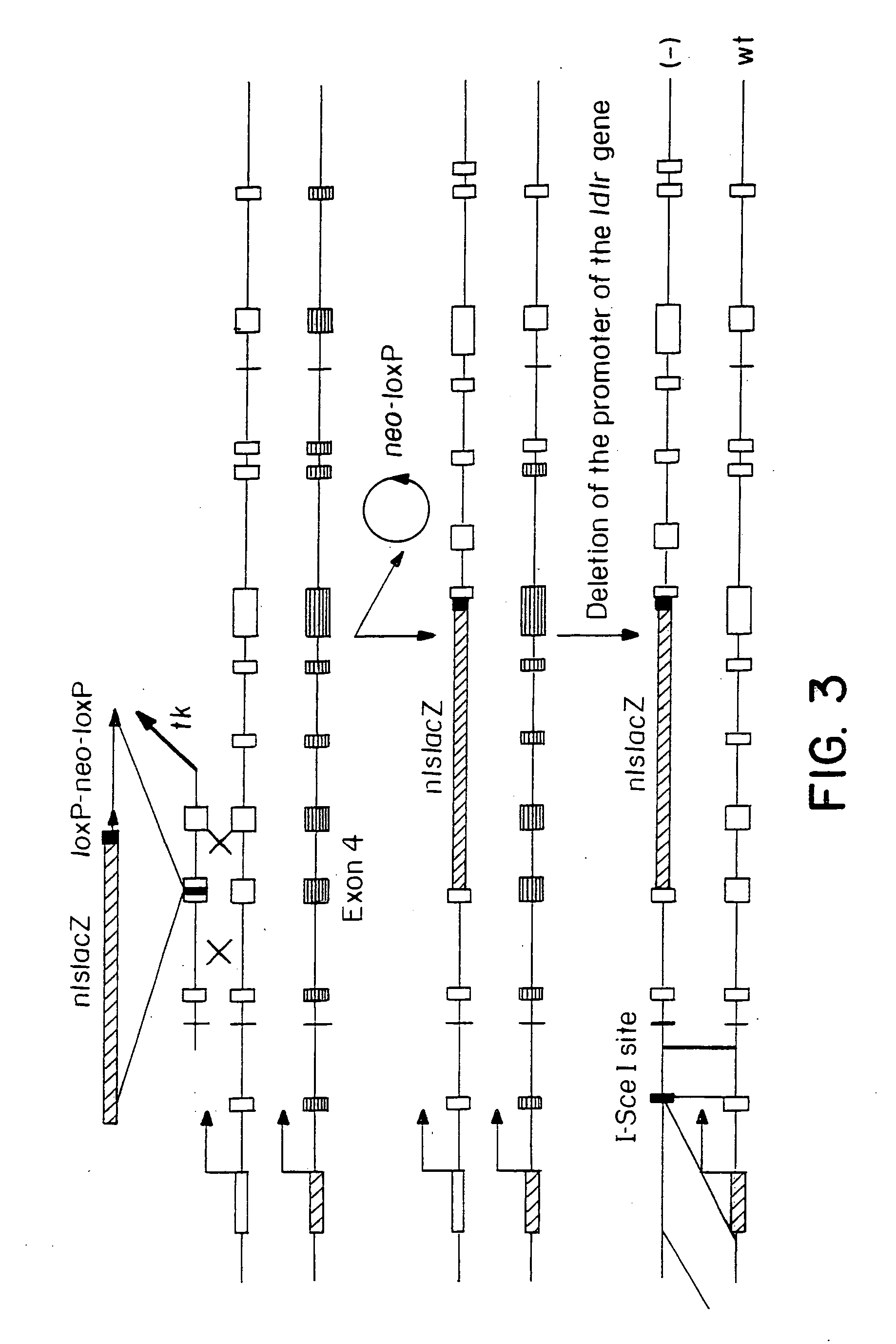Gene repair involving the induction of double-stranded DNA cleavage at a chromosomal target site
a chromosomal target site and double-stranded dna technology, applied in the direction of vectors, peptides, drug compositions, etc., can solve the problem of inherently inefficient methods for homologous recombination, and achieve the effect of high-efficiency recombinational events and efficient introduction of targeting dna
- Summary
- Abstract
- Description
- Claims
- Application Information
AI Technical Summary
Benefits of technology
Problems solved by technology
Method used
Image
Examples
example 1
Plasmid Construction
[0058] All DNA manipulations used standard techniques and procedures. Such methods are described, for example, in Sambrook et al., Molecular Cloning: A Laboratory Manual, Second Edition, Cold Spring Harbor University Press, New York (1989); and Ausubel, et al., Current Protocols in Molecular Biology, John Wiley & Sons, New York (1998). All synthetic oligonucleotides were synthesized on automated instruments using standard techniques.
[0059] The pPytknBWSacZ plasmid was constructed by inserting the oligonucleotide 5′-GATCATGCATAGGGATAACAGGGTAATAGCT-3′ (SEQ ID NO:1), paired with 5′-ATTACCCTGTTATCCCTATGCAT-3′ (SEQ ID NO:2), between the BclI-SacI restriction sites of the pPytknlslacZ plasmid (Henry et al., C. R. Acad. Sci. III, 322(12):1061-1070 (1999)). Insertion of the BclI and SacI restriction sites resulted in destruction of the BclI and the SacI restriction sites and insertion of an NsiI restriction site and an I-SceI restriction site.
[0060] The p-SlacB plasm...
example 2
Cell Line Production
[0068] 5 μg of the pPytknBWSacZ plasmid and 5 μg of the pUSVneo plasmid were cotransfected in 5×104 NIH 3T3 cells (American Type Culture Collection) in a 35 mm petri dish (Falcon) using the CaPO4 precipitation method. Forth-eight (48) hours after transfection, the tissue culture medium was supplemented with 600 μg / ml of Geneticin (Gibco BRL). Antibiotic selection was maintained during selection of Geneticin resistant clones and during subcloning. Twenty-four (24) Geneticin resistant clones were isolated and grown independently in Dulbeccos modified Eagles Medium (DMEM), 10% calf serum, for 15 days before evaluating for the presence of the nlslacZ gene.
[0069] To evaluate for presence of the nlslacZ gene, DNA was extracted from cells in all 24 cultures of Geneticin resistant clones. Fragments of the nlslacZ gene were amplified by polymerase chain reaction (PCR) as described in BioFeedback in BioTechniques, Vol. 10, No. 1, p. 56 T, Hanley & J. P. Merlie (1991). T...
example 3
Ex Vivo Recombination In NIH 3T3 Gap1 And NIH 3T3 Gap2 Cell Lines
[0073] Three sets of experiments were performed, in triplicate, using the NIH 3T3 Gap1 and NIH 3T3 Gap2 cell lines. Each set of experiments, in triplicate, comprises 8 different cotransfections of DNA mixes as shown in Table 1. Transfections were performed in either 5×104 NIH 3T3 Gap1 cells or 5×104 NIH 3T3 Gap2 cells in a 60 mm petri dish (Falcon) by the CaPO4 precipitation method.
TABLE 1MixNumberExpression PlasmidQuantityRepair MatrixQuantity1pCMV I-SceI(+)9 μgpSlacB1 μg2pCMV I-SceI(+)9 μgpBlacS1 μg3pCMV I-SceI(+)9 μgpSlacS1 μg4pCMV I-SceI(+)9 μgpBlacB1 μg5pCMV I-SceI(−)9 μgpSlacB1 μg6pCMV I-SceI(−)9 μgpBlacS1 μg7pCMV I-SceI(−)9 μgpSlacS1 μg8pCMV I-SceI(−)9 μgpBlacB1 μg
[0074] In a second set of experiments, plasmids were linearized with ScaI restriction enzyme prior to transfection. Three sets of experiments were performed, in triplicate, using the NIH 3T3 Gap1 and NIH 3T3 Gap2 cell lines. Each set of experiments...
PUM
| Property | Measurement | Unit |
|---|---|---|
| nucleic acid | aaaaa | aaaaa |
| resistance | aaaaa | aaaaa |
| floxed resistance | aaaaa | aaaaa |
Abstract
Description
Claims
Application Information
 Login to View More
Login to View More - R&D
- Intellectual Property
- Life Sciences
- Materials
- Tech Scout
- Unparalleled Data Quality
- Higher Quality Content
- 60% Fewer Hallucinations
Browse by: Latest US Patents, China's latest patents, Technical Efficacy Thesaurus, Application Domain, Technology Topic, Popular Technical Reports.
© 2025 PatSnap. All rights reserved.Legal|Privacy policy|Modern Slavery Act Transparency Statement|Sitemap|About US| Contact US: help@patsnap.com



